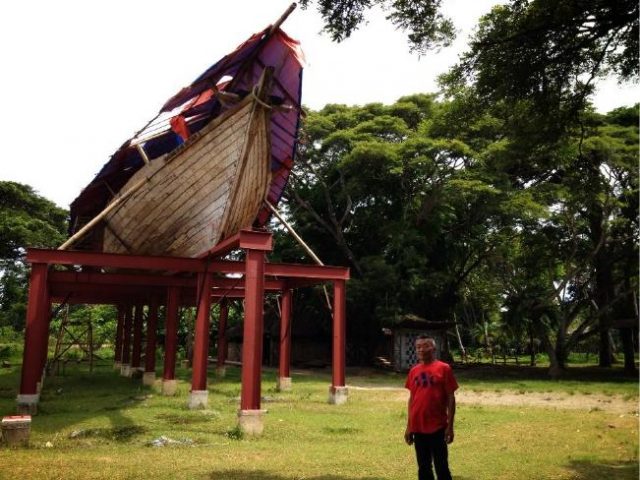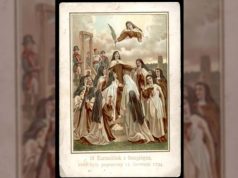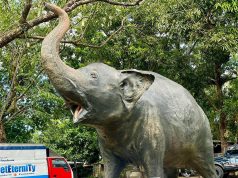MANILA, May 7 – An intrepid group of Filipino seafarers, led by Environment and Natural Resources Undersecretary Art Valdez, will retrace the first Filipino sea voyage to China – 600 years ago – using a replica of the balangay boat used by the Sultan of Sulu.
In an exclusive interview, Valdez said he and his group are scheduled and all set to leave for China.
They will start their sea voyage in Sulu, where Sultan Paduka Batara, the Muslim ruler of Sulu, together with his family and 300 of his noble followers started their journey to China “for a tribute mission to the Ming Dynasty to seek preferential trade agreement” with the Chinese.
Valdez was the organizer of the Philippine Expedition to Mount Everest that enabled the first Filipino, Leo Oracion, to reach the summit of the world’s tallest mountain on May 17, 2006.
After Oracion, two other Filipino climbers, Pastor Emata and Romi Garduce also reached the summit of Mount Everest.
Retracing ancient sea voyage
In 2010, Valdez entertained the thought of retracing the first sea voyage to China by Paduka Batara in the year 1417, or 600 years ago, aboard a replica of the balangay boat.
To test the viability of the idea, Valdez in 2010 organized a 40-man Filipino team – mostly members of the Mt. Everest expedition – to sail around the Philippine archipelago and Southeast Asia.
Three replicas of the ancient balangay boats were built.
“The team traveled from the southern corridor of Tawi-Tawi, going around Malaysia, Brunei, Indonesia, Singapore, Thailand, Cambodia and up to the territorial waters of Vietnam – a journey that took a total of 17 months.
The original plan was to reach China, but due to the sudden change of the monsoon weather and weary crew mates who longed to be with their families as the Christmas season approached, a collective decision was made to turn back home,” Valdez said.
The important thing for Valdez was that the sea voyage using a replica of the balangay succeeded as proof of concept.
One of the boats, named “Diwata ng Lahi”, is now on display at the National Museum, and has been declared as Important Cultural Property.
The second vessel “Masawa hong Butuan”, named after the ancient kingdom that is now present-day Butuan City, was returned to where she was first built, at Luna Compound beside the mighty Agusan River.
It was in Butuan where the original balangay boats were first discovered and unearthed.
The third boat, “Sama ng Tawi-Tawi”, in honor of the boat builders from the Sama Dilaya tribe of Sibutu and Sitangkai, sits patiently near the shores of Bacolod City, awaiting her call to sail again, Valdez said.
“The mission, onboard vessels very much like the balangays, was welcomed by the Ming Emperor; on his way home, the Sultan fell ill and died. Upon learning of the tragic news, the Ming Emperor ordered a royal funeral in his honor. The Sultan’s wife and two of his children remained behind in order to tend to his tomb, they were granted lands and citizenships.
“Today, descendants of the Sultan of Sulu continues to live and prosper in the City of Dezhou, 320 kilometers south of Beijing, in theProvince of Shandong.
“This year, 2017, happens to be exactly the 600th anniversary of that voyage, so what better way to commemorate this historic undertaking than to retrace that journey,” Valdez explained.
“For this voyage retracing the same route going to China, two new Balangay boats were built in Maimbung, Sulu by our Sama brothers from Tawi-Tawi,” Valdez said.
“Once ready, the two boats will sail first to Butuan City, then to Bacolod City to be joined by Balangay Sama ng Tawi-Tawi and onwards to Manila together. The boats will mostly be manned by the same crew, plus a few new selected volunteers for the China journey. With the right weather, we shall be crossing the South China Sea in the month of May and hope to be sailing back by the middle of June,” he explained.
“We are composed of different individuals with different culture and beliefs, yet we journey as one boat, as one people; with tolerance and understanding. This is something that our country needs today. Our archipelagic nature should not get in the way of our coming together as a people; the waters are there not to divide, but to unite. That was how our ancestors lived and believed, we should look back at our past for guidance just as Rizal has admonished.
“This will be a journey in celebration of our historical ties with the Middle Kingdom, a journey of understanding and cross-cultural connections, to bridge common and shared aspirations between the people of the Philippines and the people of China, a journey in remembrance for the valiant spirits of our ancestors who proudly sailed these high seas – long before the coming of foreign colonizers!” Valdez concluded, saying “Kaya ng Pinoy.”










